

The Other ‘Silent Service’ – U.S. Navy Airships of WW2. A U.S.
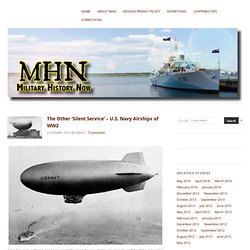
Navy helium-filled K-class blimp was 230 feet long. It’s crew of 10 could patrol stay aloft for 38 hours travelling at a cruising speed of 58 mph. When America suddenly found itself at war following the attack on Pearl Harbor, military planners in Washington realized they had neither the warships nor aircraft to defend more than 12,000 miles of U.S. coastline against enemy submarines lurking off shore. Short on options, the U.S. Navy turned to some decidedly outdated technology to bolster the nation’s maritime defences – blimps. Beginning in 1942 and continuing through to the end of the war, armed naval airships carried out non-stop patrols high above American waters in search of Japanese subs and German U-boats.
However, despite their contributions to the Allied war effort, blimp crews fought in relative obscurity – instead, warplanes and fighting ships captured headlines as well as the public’s imagination. A German Zeppelin raids Warsaw in 1915. • U.S. Like this: Like Loading... "K" Class Airships had a long and heroic history since WWII in antisubmarine warfare, patrol, and rescue. The K-ships were a lot smaller than the Nan-ship but have a much more colorful and longer history.
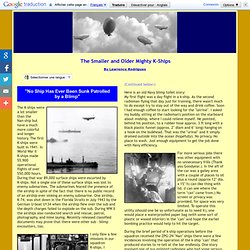
The first K-ships were built in 1941. In World War II K-ships made 55,900 operational flights of over 550,000 hours. During that war 89,000 surface ships were escorted by K-ships. Not a single one of these surface ships was lost to enemy submarines. Sikorsky R-4B Hoverfly. Developed by Igor Sikorsky from his famous VS-300 experimental helicopter, the R-4 became the world's first production helicopter, and the U.S.
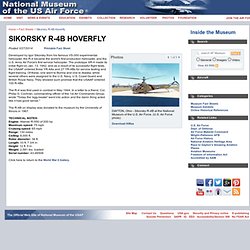
Army Air Force's first service helicopter. The prototype XR-4 made its initial flight on Jan. 13, 1942, and as a result of its successful flight tests, the USAAF ordered three YR-4As and 27 YR-4Bs for service testing and flight training. Of these, one went to Burma and one to Alaska, while several others were assigned to the U.S. Navy, U.S. Coast Guard and British Royal Navy. The Campaign for the National Museum of the United States Army. Second Lieutenant Carter Harman (standing left) and ground crew pose in front of an R-4.
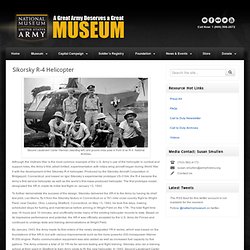
National Archives. Boeing 314 Clipper (C-98) - Long-Range Flying Boat. The Boeing Model 314 "Clipper" was a flying boat developed by Boeing Aircraft Company to fulfill a Pan American requirement for a long-range passenger flying boat transport.

The system saw only 12 examples produced in two variants and could ferry up to 68 passengers in late 1930's/early 1940's comfort. Clippers served in a military capacity once the war was in full swing for America, gradually returning to civilian flight in the post-war world - naturally outclassed by the new crop of longer-range aircraft no available. The 314 Clipper followed suit with other flying boat aircraft designs of the time, featuring a monocoque stout fuselage and high-mounted engines on a monoplane wing assembly.
The crew sat high atop the flight deck and consisted of 11 personnel that would include stewards. Make no mistake that these aircraft were built with a certain clientele in mind. Text ©2003-2014 www.MilitaryFactory.com. Specifications for theBoeing 314 Clipper (C-98)Long-Range Flying Boat Crew: 11. Northrop P-61C Black Widow. The heavily-armed Black Widow was the United States' first aircraft specifically designed as a night-fighter.

The P-61 carried radar equipment in its nose that enabled its crew of two or three to locate enemy aircraft in total darkness and fly into proper position to attack. The XP-61 was flight-tested in 1942 and the delivery of production aircraft began in late 1943. The P-61 flew its first operational intercept mission as a night fighter in Europe on July 3, 1944, and later was also used as a night intruder over enemy territory. In the Pacific, a Black Widow claimed its first "kill" on the night of July 6, 1944. As P-61s became available, they replaced interim Douglas P-70s and Bristol Beaufighters in all USAAF night fighter squadrons.
During World War II, Northrop built approximately 700 P-61s; 41 of these were C models manufactured in the summer of 1945 offering greater speed and capable of operating at higher altitude. Northrop P-61 / F-61 Black Widow - Nightfighter / Reconnaissance Aircraft. The Northrop P-61 Black Widow became the United States' first aircraft specifically designed from the outset as a platform dedicated to the fine art of night-fighting.

Enabled by its complex through highly-effective nose-mounted radar, a distinct overall black paint scheme, its trained crew of three (though sometimes two) specialists and a heavy base armament made up of cannon and heavy machine guns, the "Widow" made its way into all major theaters encompassing World War 2. The P-61 could operate in total darkness, aided by its onboard systems, and move into position to deliver an enemy aircrew's final moments.
The Black Widow appeared in quantity during 1944, then under the command of the US Army Air Force (USAAF) and soldiered on well past the war years into 1952, retiring with the newly-minted United States Air Force. P-51 Mustang. A veteran of two wars -- World War II and the Korean War -- North American Aviation's P-51 Mustang was the first U.S. fighter airplane to push its nose over Europe after the fall of France.

Then called the P-51, it scurried back and forth across the channel, taking on the best the Axis could put in the air. Mustangs met and conquered every German plane from the early Junkers to the sleek, twin-jet Messerschmitt 262s. Although first designed for the British as a medium-altitude fighter, the Mustang excelled in hedge-hopping strafing runs and long-range escort duty.
It made a name for itself by blasting trains, ships and enemy installations in western Europe and by devastating Axis defenses prior to the Allied invasion of Sicily and Italy. North American P-51 Mustang" The North American P-51 Mustang was involved in one of the unusual twists of World War II.
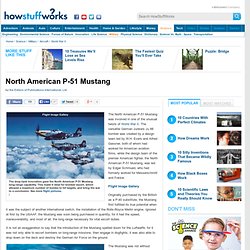
The versatile German Junkers Ju 88 bomber was created by a design team led by W.H. Evers and Alfred Gassner, both of whom had worked for American aviation firms, while the design team of the premier American fighter, the North American P-51 Mustang, was led by Edgar Schmued, who had formerly worked for Messerschmitt and Fokker. Flight Image Gallery. North American P-51D Mustang. North American P-51 / F-51 Mustang - Fighter / Fighter-Bomber / Reconnaissance. The North American P-51 Mustang proved an invaluable addition to the Allied cause in the latter half of World War 2.
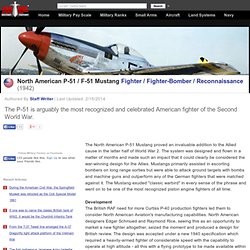
The system was designed and flown in a matter of months and made such an impact that it could clearly be considered the war-winning design for the Allies. Mustangs primarily assisted in escorting bombers on long range sorties but were able to attack ground targets with bombs and machine guns and outperform any of the German fighters that were matched against it. The Mustang exuded "classic warbird" in every sense of the phrase and went on to be one of the most recognized piston engine fighters of all time. Development The British RAF need for more Curtiss P-40 production fighters led them to consider North American Aviation's manufacturing capabilities. North American designers Edgar Schmued and Raymond Rice, seeing this as an opportunity to market a new fighter altogether, seized the moment and produced a design for British review. Crew: 1.
DB-7/A-20 Boston/Havoc Attack Bomber. The Douglas DB-7/A-20 Havoc was the most-produced attack bomber during World War II. A total of 7,477 DB-7/A-20s were built, most at Douglas, although 380 were built at the Boeing plant in Seattle, Wash. The Havoc was a mid-wing, twin-engine, three-place medium bomber that earned a reputation for getting its crews home, even when both crew and aircraft suffered crippling blows. It was called the "Boston" when it was built for England's Royal Air Force. It entered production when, despite official neutrality in 1938, there was little doubt in the United States that the country should support its allies, Britain and France. The French saw the secret bomber project at the Douglas Santa Monica, Calif., facility and ordered the first 107 DB-7s; they were to be delivered to the French Purchasing Commission at Santa Monica starting in October, with deliveries made by ship to Casablanca.
Douglas A-20 Havoc / Boston - Light Bomber / Night-Fighter. The Douglas A-20 Havoc served Allied forces through most of World War 2, fighting for British, American and Soviet forces. The type saw extensive use, proving itself a war-winner capable of withstanding a great deal of punishment but living up to its namesake in turn thanks to its speed and inherent firepower. Her crews put the aircraft through its paces with production topping over 7,000 units and several major production variants.
Douglas A-20 Havoc. In British Commonwealth air forces, bomber/attack variants of the DB-7 were usually known by the service name Boston, while night fighter and intruder variants were usually known as Havoc. An exception to this was the Royal Australian Air Force, which referred to all variants of the DB-7 by the name Boston.[1] The USAAF referred to night fighter variants as P-70. Design and development[edit] In March 1937, a design team headed by Donald Douglas, Jack Northrop and Ed Heinemann produced a proposal for a light bomber powered by a pair of 450 hp (336 kW) Pratt & Whitney R-985 Wasp Junior radial engines mounted on a high-mounted wing.
It was estimated that it could carry a 1,000 lb (454 kg) bomb load at 250 mph (400 km/h). Reports of aircraft performance from the Spanish Civil War indicated that this design would be seriously underpowered, and it was subsequently cancelled. Advancements in Technology in World War II. How Things Work: Cabin Pressure.